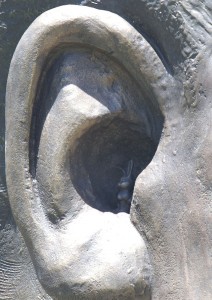Easter eggs are cute devices. I don’t mind them in movies, games, ads—not even in arts and literature. They’re an unexpected connection that happens, sometimes, between creator and the innumerable cadre of explorers who’ve peeled back a layer of whatever to find that hidden message of whatever. It’s fun.
It should go without saying, then, that the laying of such eggs should only happen when fun’s appropriate.  “Appropriate” might not apply to all art—probably not much public art.. and certainly not commissioned monumental public art meant to honor the father of a nation.
“Appropriate” might not apply to all art—probably not much public art.. and certainly not commissioned monumental public art meant to honor the father of a nation.
Sculptors Andre Prinsloo and Ruhan Janse van Vuuren agreed to create the 30-foot tribute to Nelson Mandela with the understanding that the monument was to be about the subject, not the artists. Like many public arts project it was to be unsigned, so that its story, for eternity, would only be about the onetime prisoner of  Robbin Island, who became president of South Africa.
Robbin Island, who became president of South Africa.
The statue was unveiled at the capital in Pretoria, shortly after Mandela’s death in mid-December. It’s taken a few weeks, but some sharp eyes have finally spotted the artists’ signature, their easter egg, barely visible way up high in Mandela’s right ear.
The artists have apologized, and have offered up some convoluted symbology for an explanation (the Dutch word for rabbit, haas, is the same as for “haste.” They were bitching about being rushed to finish). Authorities in South Africa have graciously accepted their apology but are left with the prospect of putting a man with a grinder in a cherry-picker, so as to permanently erase a case of artists’ hubris.
That’ll be done easily enough, and the whole sorry episode will be easily enough forgotten. With a bit of luck the Mandela statue will stand for generations, and all those generations will know the Mandela story—but not a one of them will know of the rabbit-in-the-ear sideshow that flared up when the statue was new.
Until very recently you could see a peculiar variety of unsigned public art in just about every town in America. There were a spate of post offices all newly built or at least remodeled and spruced up, during the coast-to-coast public-works stimulus of the 1930s. Most of these post offices are being pulled down now, but for three quarters of a century you could see soaring murals and discreet statuary and carvings, uplifting these very utilitarian public spaces. They were a product of one of Roosevelt’s ‘alphabet agencies,’ like the Works Progress Administration, in this case tasked to find, or more accurately create work for unemployed artists. The artists responded beautifully, and their art was viewed for decades. The question of their signature, their need or even their right to tie their identity to their commission, was absurdly irrelevant.
And these guys put a rabbit in Nelson Mandela’s ear.
They’re clearly talented. Their craftsmanship is self-evident. They have a right, I suppose, to be proud of their work. They have a right, I accept, to develop egos like most artists and writers. It’s hard to avoid.
But they, like everyone, should have the strength to stifle ego whenever that’s called for. And they should have the discernment to know when it’s called for. That’s not a matter of being a working professional, or even a journeyman artist. It’s a matter of being a grownup.